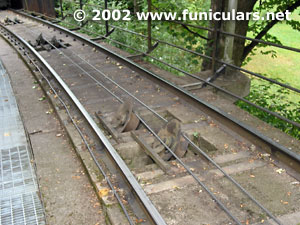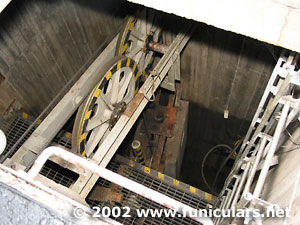|
s
How a funicular works

The cable wheels that carry the cable. Funicular at Skansen.
|
The cable
The most common type of power is a cable that runs from the one car to the upper station, through the driving wheel, and back down to the other car. The two cars balance each other's weight. The weight of the car on its way down helps pull the other car up the incline; at the same time, the car on its way up acts as a braking force for the car going down.
The cable runs between the rails in small cable wheels that are partially sunk between the tracks. On the funicular at Åre, these cable wheels have been replaced with small yellow plastic blocks, which require less maintenance.
At the meet station at the midpoint of the line, with the rails crossing each other, the rails have small breaks in them to allow the cable to pass through them.

The deep well at the lower station with the wheel and weights that maintain cable tension. Funicular at Skansen.
|
Two cables
Modern funiculars actually have two cables. The other cable goes, instead, down from one car to the lower station, and back to the other car. At the lower station, there is a mechanism to tension this cable. The funicular at Skansen has a deep well at the lower station that this cable passes into and around a wheel with large weights attached, to keep the cable correctly tensioned.
 previous page - contents - next page previous page - contents - next page 
© Text och photo: Bruse LF Persson
|